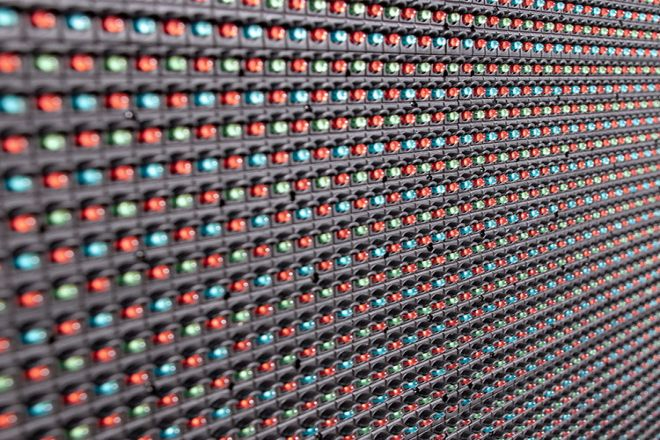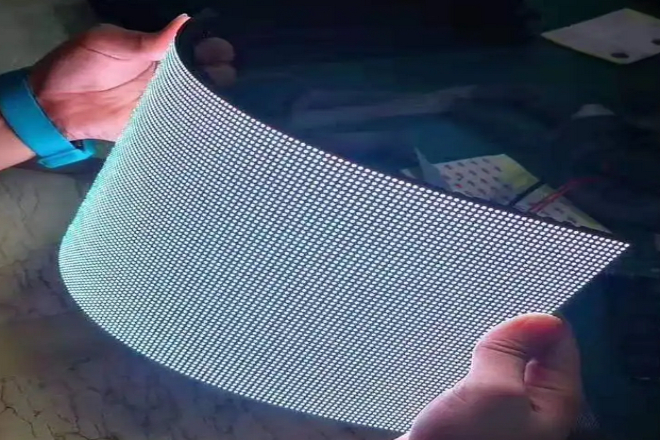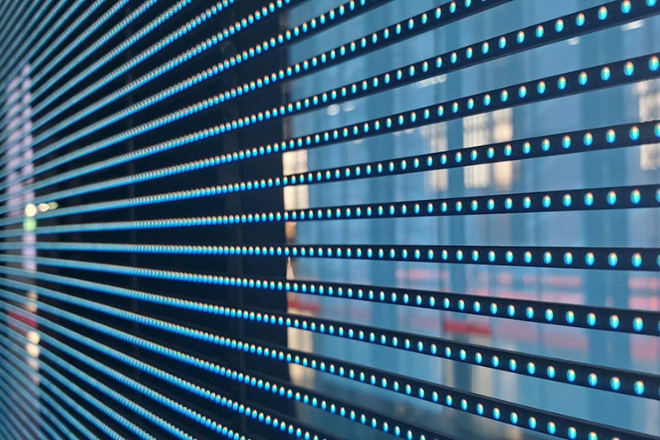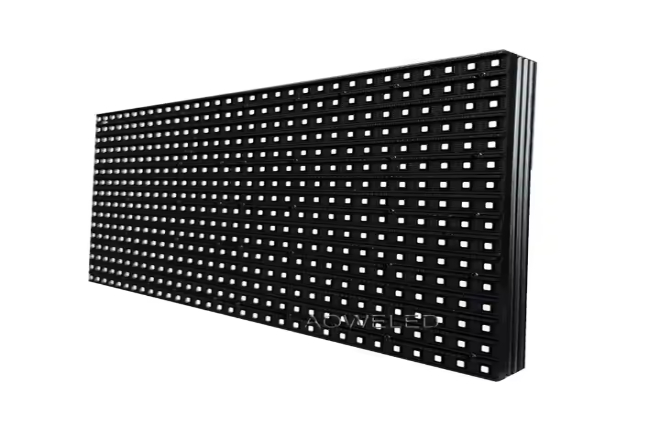Introducción

En la era digital actual, pantallas de visualización LED are widely used in advertising, stage, transportation and other fields due to their advantages such as high efficiency, energy saving and rich colors.
However, a confusing phenomenon is that the lamp beads of some LED display screens frequently fail during use, seriously affecting the display effect and service life.
This article will explore in depth why some LED display lamp beads break easily?
Tabla de contenido
1. Basic introduction to LED display lamp beads
LED display lamp beads, in simple terms, are small light-emitting points that make up LED display screens. It consists of several parts: chips, packaging materials and pins.
The chip is the “heart” of the lamp bead, made of semiconductor materials such as gallium arsenide, gallium phosphide, gallium nitride, etc. After power is turned on, electrons and holes recombine in the chip, generating photons and emitting light.
The packaging material is like the “outer coat” of the lamp bead, protecting the chip from damage by the outside environment, such as moisture-proof, dust-proof, and bump-proof.
It can also adjust the direction and intensity of the light to make the light emit better. The pin is like the “wire” of the lamp bead, which leads the external electricity to the chip so that the chip can emit light normally.
LED lamp beads emit light because electrons and holes recombine. When the power is turned on, electrons and holes meet near the PN junction of the chip, and electrons jump from high energy level to low energy level, releasing energy and forming photons.
Chips of different materials emit different colors of light. For example, gallium arsenide chips emit red light, and gallium nitride chips can emit blue or green light.
The factors that affect the luminous efficiency of lamp beads are material quality, chip structure design, and packaging process.
Good material quality, fewer defects in the chip, smooth recombination of electrons and holes, and high luminous efficiency. Reasonable chip structure design can make it easier for electrons and holes to meet and recombine.
Good packaging technology can make the light emit better and can also dissipate the heat generated by the chip so that the lamp beads can emit more stably.
2. Introduction to the performance indicators of LED display lamp beads

There are three main performance indicators of LED display lamp beads: brightness, chromaticity, and life. These indicators determine whether the display is easy to use and how long it can be used.
Let’s talk about brightness first. Simply put, it is how bright the lamp beads are. There are several ways to measure brightness, such as light intensity, brillo, and luminous flux.
Light intensity refers to how strong the light can be emitted by the lamp beads in a certain direction.
Brightness refers to how bright the light-emitting surface of the lamp beads is; and luminous flux refers to how much light the lamp beads can emit in total. Brightness is very important.
If the lamp beads are not bright enough, the display screen will not be clear in the sun; if they are too bright, it will waste electricity. The right brightness allows the display screen to display content clearly in various environments and save electricity.
Let’s talk about chromaticity, which is the color of the light emitted by the lamp beads. It mainly depends on two things: color temperature and color rendering index. Color temperature refers to the color of light, and the unit is Kelvin (K).
When the color temperature is low, the light is yellowish and looks warm; when the color temperature is high, the light is white or blue and looks cold. The color rendering index is to see whether the lamp beads can accurately restore the color of the object.
The range is 0 to 100. The higher the value, the better the color restoration. In order to make the display screen display well, the color temperature of lamp beads of different colors must be similar, and lamp beads with a high color rendering index must be selected.
If the color temperature is different, the color of the display screen will be messy; if the color rendering index is low, the color will not be bright.
Finally, the lifespan is how long the lamp beads can be used. The lifespan is generally determined by how long the lamp beads are used when the brightness drops to 70% of the initial brightness.
There is a method for testing the lifespan called accelerated life test, which is to put the lamp beads in a high temperature and high humidity environment to make them age quickly and then calculate how long they can be used normally based on the light attenuation rate.
Factors affecting the lifespan include temperature, current, material quality, and packaging process. If the temperature is too high, the lamp beads are easy to break; if the current is too large, the lamp beads are also easy to break.
If the material quality is not good, the lamp beads have a short lifespan; if the packaging process is not good, the lamp beads are also easy to break.
3. Reasons why LED display lamp beads are easily damaged
Quality problems are a major reason for the lamp beads to break.
When producing lamp beads, if the chip has defects, such as some impurities or incomplete crystal structure, the electrons and holes will not recombine smoothly, the luminous efficiency will be low, and it may not light up directly.
The packaging is also critical. If the packaging material is of poor quality or the packaging process is not good, such as if the seal is not tight, water vapor and dust will easily get in and corrode the chip and pins.
In addition, if the thermal expansion coefficients of the packaging material and the chip are different, stress will be generated when the temperature changes, which will damage the chip.
These problems may cause the lamp bead to break down in a short time.
When the lamp bead is working, the parameters such as voltage, current, and power must be appropriate.
If the voltage or current is too high, the lamp bead will be overloaded, generating a lot of heat, and the chip will easily age or even burn out directly. Too much power will also have the same problem.
Moreover, if the electrical characteristics of the lamp bead are unstable, such as the voltage always fluctuating, the lamp bead will flicker, and the brightness will be unstable, which will not only look uncomfortable but also shorten the life of the lamp bead.
When the LED lamp bead is working, it will heat up. If this heat cannot be dissipated, the temperature of the lamp bead will rise.
When the temperature is high, the luminous efficiency of the chip will decrease, and the packaging material will age faster.
Moreover, long-term high temperatures will cause problems in the structure of the lamp beads, such as loose pins, poor chip performance, and finally, the lamp beads will break.
Therefore, heat dissipation is very important. For example, heat sinks, fans, etc. can be used to help the lamp beads dissipate heat so that the lamp beads can work at a suitable temperature.
Environmental factors also have a great impact on lamp beads. If the temperature is too high, the lamp beads will age quickly; if the humidity is high, the lamp beads are prone to moisture, short circuit, or corrosion.
If there is too much dust, it will block the heat dissipation channel and affect heat dissipation.
In order to reduce the damage of these environmental factors, some protective measures can be taken, such as applying a waterproof and dustproof coating on the surface of the lamp beads or installing a dehumidifier on the display screen to keep the environment dry.
Finally, the drive circuit problem cannot be ignored. If the drive circuit is unstable, the voltage and current of the lamp beads will be unstable, affecting the normal operation of the lamp beads.
Common problems include short circuits, open circuits, voltage fluctuation, etc.
A short circuit will cause too much current to burn the lamp beads; an open circuit will prevent the lamp beads from emitting light; voltage fluctuation will make the brightness of the lamp beads unstable.
To solve these problems, it is necessary to regularly check and maintain the drive circuit, replace broken components in time, and ensure that the drive circuit can operate stably.
4. Reliability test method of LED display lamp beads

The reliability test of LED display lamp beads is to see how long these small lamp beads can be used and whether they can withstand various environments and toss. There are several main test methods:
This is like turning on the “fast forward” mode for the lamp beads. We know that the lamp beads age quickly when the temperature is high.
Therefore, put the lamp beads in a very hot place, such as 85℃, and then keep the power on and let it work continuously for 1000 hours.
If the lamp beads can still emit light normally during this period and the brightness does not drop too much, it can be inferred that it should be able to be used for a long time at a normal temperature.
This method can judge the life of the lamp beads in a short time without waiting for several years to see the results.
It is to put the lamp beads in various extreme environments to see if they can withstand it.
For example, in the high-temperature test, the lamp beads are placed in a particularly hot box, the temperature is adjusted to 85℃, and it is left there for 1000 hours to see if it can still work normally and whether the brightness has dimmed.
The low-temperature test is to put the lamp beads in an environment of minus 40℃ to see if they can light up in the ice and snow.
The humidity test is even more severe; the temperature is 85℃, the humidity is 85%, and it is hot and humid, just like in a tropical rain forest, to see if the lamp beads can survive in this environment.
The salt spray test is even more ruthless, putting the lamp beads in a box full of salt spray to simulate the wet and salty environment of the seaside to see if the lamp beads will rust or change color.
Through these tests, you can know whether the lamp beads can survive in various harsh environments. If they can pass, there will be no problem in ordinary environments.
It is to see if the lamp beads can withstand various tossing. The vibration test is to make the lamp beads work under vibrations of various frequencies and amplitudes, just like putting it on a bumpy car to see if it will be damaged by the vibration.
Impact testing is to give the lamp beads a sudden and large impact, just like accidentally dropping a display screen to see if the lamp beads will break.
Through these tests, we can find out whether the lamp beads will break when subjected to mechanical impact. If they can pass, then we will be more assured during transportation and use.
Through these tests, we can know whether the lamp beads are reliable.
If the lamp beads can pass these tests, then in actual use, no matter if they encounter high temperature, low temperature, humidity, or bumps and impacts, they can emit light steadily, and the service life will be more guaranteed.
5. Maintenance and care of LED display lamp beads
Although LED display lamp beads are quite durable, they still need to be well maintained and cared for if they are to be used longer and display better. Below, I will explain in detail how to maintain and care for these small lamp beads.
1). Daily inspection
1.1). Appearance inspection
- Inspection content:
Mainly to see if the lamp beads have obvious damage. For example, whether there are cracks in the shell, whether the pins are bent or broken.
If these small problems are not handled in time, they may cause the lamp beads to short-circuit or have poor contact, affecting the effect of the entire display.
- Inspection method:
You can use a magnifying glass to carefully look at the surface of the lamp beads, especially the packaging part and the pins. If you find dust or dirt, you can use a soft brush to gently sweep it away.
Don’t underestimate these dusts. If they accumulate too much, they will affect heat dissipation and make the lamp beads more likely to break.
- Potential problems:
If you find cracks in the shell of the lamp beads or loose pins, you must deal with them quickly.
Otherwise, the lamp beads may have poor contact or even short circuits, causing black spots or flickering on the display.
1.2). Electrical inspection
- Inspection content:
Mainly check the electrical connection of the lamp beads to ensure that each lamp bead can conduct electricity normally.
Also, check whether the driving circuit is stable and whether the voltage and current are within the normal range. If these parameters are not correct, the lamp beads are prone to problems.
- Inspection method:
Use a multimeter to measure the voltage and current of the lamp beads to see if they are within the specified range. If the voltage or current of a lamp bead is found to be abnormal, the lamp bead may be damaged, or there is a problem with the electrical connection.
- Potential problems:
If the voltage or current of the lamp bead is too high, the lamp bead will overheat, accelerate aging, or even burn directly.
If the voltage or current is too low, the lamp bead may not emit enough light, causing dark spots or flickering on the display.
2). Cleaning and protection
2.1). Cleaning method
- Cleaning tools:
Use a soft brush, dust-free cloth, and a special cleaning agent. Do not use hard tools or corrosive cleaning agents; otherwise, the surface of the lamp beads will be damaged.
2.2). Cleaning steps:
- Turn off the power:
Before cleaning, be sure to turn off the power of the display screen for safety.
- Sweep away dust:
Use a soft brush to gently sweep away dust and debris on the surface of the lamp beads. This step is very important because too much dust will affect heat dissipation.
- Wipe the surface:
Dip a small amount of detergent with a dust-free cloth and gently wipe the surface of the lamp beads to remove stains and oil stains. This process should be gentle so as not to damage the lamp beads.
- Drying:
Use a clean, dust-free cloth to dry the surface of the lamp beads to ensure that there is no residual detergent. Residual detergent may corrode the surface of the lamp beads.
- Nota:
Be gentle when cleaning, and do not damage the lamp beads. If the lamp beads are accidentally damaged, it will be more trouble than gain.
2.3). Protective measures
- Protective materials:
You can choose waterproof, dustproof, and moisture-proof protective materials, such as waterproof coatings, dust covers, etc. These materials can effectively prevent environmental factors from damaging the lamp beads.
2.3.1). Protective methods:
- Waterproof coating:
Apply a layer of waterproof coating on the surface of the lamp beads to prevent water vapor and dust from entering the interior of the lamp beads. This coating is like putting a layer of “protective clothing” on the lamp beads.
- Dust cover:
Installing a dust cover on the outside of the display can effectively block dust and debris. Especially in dusty environments, the role of the dust cover is even greater.
- Sealing treatment:
Make sure that the joints and interfaces of the display are well sealed to prevent water vapor and dust from entering. This step is very important because water vapor and dust are the “natural enemies” of lamp beads.
- Nota:
The selection of protective materials should be determined according to the actual use environment to ensure its compatibility with the lamp beads. If the protective material and the lamp beads are incompatible, the lamp beads may be damaged.
3). Troubleshooting
3.1). Dead lamp
- Fault phenomenon:
A certain lamp bead is not lit, and the surrounding lamp beads are normal. This situation is very common. It may be that the lamp bead is broken or there may be a problem with the electrical connection.
3.1.1). Troubleshooting method:
- Check the electrical connection:
Use a multimeter to check the electrical connection of the lamp bead to see if there is a short circuit or open circuit. If there is a problem with the electrical connection, repair it in time.
- Replace the lamp bead:
If the lamp bead is found to be damaged, you can replace it with a new one. When replacing, be sure to ensure that the electrical parameters of the new lamp bead are consistent with the original lamp bead.
- Nota:
After replacing the lamp bead, recheck the electrical connection to ensure that the new lamp bead can work properly. If you do not check, the new lamp bead may also have problems.
3.2). Flickering
- Fault phenomenon:
A lamp bead or a group of lamp beads flickers, and the brightness is unstable. This situation is very annoying and will affect the display effect of the display.
3.2.1). Troubleshooting method:
- Check the voltage and current:
Use a multimeter to measure the voltage and current of the flashing lamp bead to see if they are within the normal range. If the voltage or current is unstable, there may be a problem with the drive circuit.
- Check the drive circuit:
Check whether the drive circuit is stable and see if there is any voltage fluctuation or short circuit. If there is a problem with the drive circuit, repair or replace it in time.
- Replace the lamp bead or drive circuit:
If the lamp bead is found to be damaged, you can replace it with a new one; if there is a problem with the drive circuit, you need to replace or repair the drive circuit.
- Nota:
When troubleshooting, be sure to ensure that the operation is standardized to avoid damage to other lamp beads or circuits. Improper operation may cause more lamp beads to be damaged.
3.3). Light attenuation
- Fault phenomenon:
The brightness of the lamp beads gradually dims, affecting the overall brightness of the display. This situation is a common phenomenon of lamp bead aging.
3.3.1). Troubleshooting method:
- Check heat dissipation:
Check the heat dissipation of the lamp beads to see if there is any poor heat dissipation. If the heat dissipation is poor, clean the heat dissipation channel or replace the radiator.
- Check electrical parameters:
Check whether the voltage and current of the lamp beads are within the normal range to avoid overload. If the voltage or current is too high, the lamp beads will accelerate aging.
- Replace lamp beads:
If the lamp beads have aged, you can replace them with new ones.
- Precauciones:
Light attenuation is a natural aging phenomenon of lamp beads, but by optimizing heat dissipation and electrical parameters, its aging speed can be slowed down. If no measures are taken, the lamp beads will age faster.
Through daily inspection, cleaning and protection, and troubleshooting, the service life of LED display lamp beads can be effectively extended to ensure that the display is always in good working condition.
Regular maintenance and care can not only improve the reliability of the display but also reduce maintenance costs and extend its service life.
6. Selection and optimization of LED display lamp beads

1). Lamp bead selection
Choosing lamp beads is like choosing dishes. You have to choose the right materials according to the recipe (application scenario).
The same is true for LED display lamp beads. You have to choose the right lamp beads according to their purpose, mainly looking at the indicators of brightness, chromaticity, and lifespan.
1.1). Brightness:
Imagine that you are looking at the screen of your mobile phone under the sun. If the screen is not bright enough, can you not see it clearly? The same is true for LED displays, especially outdoor displays.
You have to choose lamp beads with high brightness so that you can see clearly even under strong light. For example, 5050 model LED lamp beads have high power and high brightness, which are suitable for outdoor use.
1.2). Chromaticity:
Chroma is like “adjusting the color” of the lamp beads. The color temperature determines whether the color of the light is warm or cold, and the color rendering index determines whether the color is restored well.
For example, stage lights require lamp beads with a high color rendering index so that the colors on the stage can be restored more realistically.
1.3). Lifespan:
Lifespan is how long the lamp beads can be used. Good lamp beads have a long lifespan, are worry-free to use, and can also reduce maintenance costs. It’s like buying a durable light bulb that can be used for a long time and replaced less frequently.
2). Packaging technology optimization
Packaging technology is like putting clothes on the lamp beads, and different clothes have different functions. There are several packaging forms:
2.1). SMD packaging:
This packaging is like sticking the lamp beads on the circuit board. It is small in size and suitable for mobile phones, computer screens and other places where space needs to be saved.
2.2). DIP packaging:
This packaging is like plugging the lamp beads on the circuit board. Although it is large in size, it has good heat dissipation and is suitable for high-power lamps.
2.3). COB packaging:
This packaging integrates several lamp beads together, with high brightness and good heat dissipation, and is suitable for scenes such as stage lighting that require high brightness.
2.4). Built-in IC packaging:
This packaging is like installing a small computer in the lamp bead, which can control the brightness and color changes of the lamp bead, and is suitable for smart lighting and display screens.
The quality of packaging technology directly affects the life of the lamp bead. For example, good packaging materials and processes can reduce the heat dissipation problem of the lamp bead and make the lamp bead last longer.
3). Circuit design optimization
Circuit design is like the process of “powering” the lamp beads. Whether the design is good or not directly affects the life of the lamp beads.
3.1). Constant current drive:
Just like “feeding” the lamp beads, a constant current drive can ensure that the lamp beads “eat” the same amount of food each time so that the lamp beads can work stably and will not break down due to “eating too much” or “eating too little.”
3.2). Overcurrent protection:
It is like “wearing armor” on the lamp beads to prevent the lamp beads from being “injured” by excessive current. Adding overcurrent protection to the circuit can prevent the lamp beads from burning out due to excessive current.
3.3). Heat dissipation design:
The lamp beads will heat up when working, just like people will sweat after exercise. Heat dissipation design is to help the lamp beads “dissipate heat” so that the lamp beads will not break down due to overheating. For example, heat sinks, fans, etc., can be used to help the lamp beads cool down.
3.4). Electromagnetic compatibility design:
This is a bit like “vaccinating” the lamp beads to prevent them from interfering with surrounding equipment or being interfered with. Through reasonable circuit design, the impact of lamp beads on surrounding equipment can be reduced.
By optimizing packaging technology and circuit design, LED display lamp beads can be used longer and more stably. In this way, the quality and reliability of the entire display can be greatly improved.
7. Conclusión
The above is why lamp beads are so easy to damage. In fact, there is another way to avoid easily damaged lamp beads, that is, to choose the right brand of LED display lamp beads.
Nationstar is a better brand, but there are many “fake” ones on the market. As a buyer, you have to carefully distinguish them. Of course, we can also provide you with a Nationstar lamp bead inspection if you need it.
Finalmente, si quieres saber más sobre las pantallas LED, Por favor póngase en contacto con nosotros.
